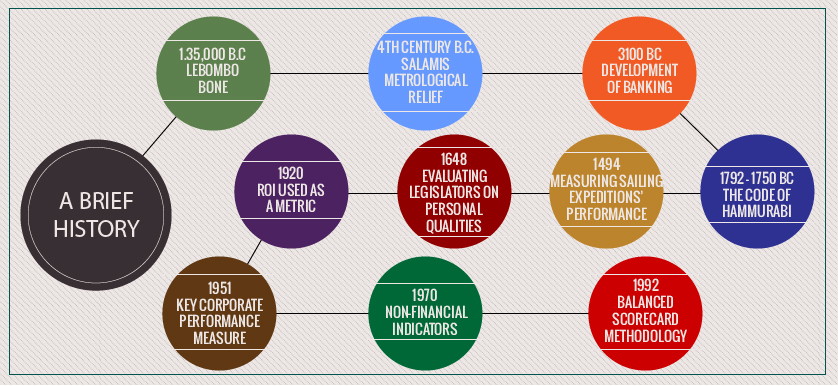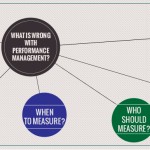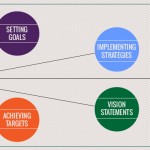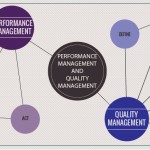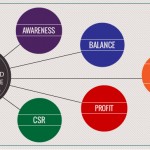Learning from practice – A brief history of performance measurement
smartKPIs.com Performance Architect update 31/2010
Measurement is in the realm of mathematics. It is about keeping track, about establishing dimensions. Some of the earliest measurement activities in human history track back to 35,000 B.C. (Lebombo bone) and 9,000-6,500 B.C. (Ishango bone). Researchers consider them the first measurement tools in human history used for measuring intervals of time.
The Salamis metrological relief, dating back to the 4th century B.C. is considered an important measurement tool for architecture, as it illustrates the correlation between the different measuring systems used in Ancient Greece: Doric, Ionic and Common. This unification facilitated the construction of one of the symbols of civilization: the Parthenon, incorporating beauty, science and art.
In a business, measuring is linked to the use of money and can be traced back to Mesopotamia, where writing was first invented (3100 BC), banking was first developed (3000-2000 BC), and laws were first used to regulate banking operations (1792 – 1750 BC, The Code of Hammurabi).
Standards around measurement in a business environment are owed to the Venetians, who evaluated the performance of their sailing expeditions by calculating the difference between the investment made by the ship owner and the money obtained by selling the goods brought back by the journey. Venice merchant’s need for a more elaborate approach to evaluating outcomes lead to double-entry bookkeeping system, described by Luca Pacioli’s: ‘Summa de arithmetica, geometrica, proportioni et proportionalita’ (‘Everything on arithmetic, geometry, proportions and proportionality’), published in Venice in 1494. While Pacioli is considered today the “father of accounting”, the emergence of the discipline represents one of the earliest illustrations of learning from practice.
From this point on, the evolution of measurement in business was driven by three institutions: church, military and the public service, at both organizational and individual level. In mid 1500s, Ignatius Layola instituted a procedure to formally rate members of the Jesuit Society. In 1648 Dublin Evening Post in Ireland evaluated legislators by using a rating scale based upon personal qualities. Most Western armies did appraisals as early as the 19th century.
One of the earliest books on performance measurement that used used the term “measure” in the context of evaluating performance is: Efficient Democracy, by William Harvey Allen. It was written in 1907, not before the age of management consultants, business schools and strategy gurus. Allen was a practitioner, secretary of the Committee on Physical Welfare of School Children and General Agent of the New York Association for Improving the Condition of the Poor. He wrote on education, healthcare and philanthropy.
In 1920-1925 DuPont started using Return on Investment as a performance measure, one in a long series of business and technology innovations that emerged from the company.
In 1951, General Electric introduced the use of key corporate performance measure, through an initiative commissioned by the then CEO, Ralph Cordiner. The selected measures were grouped in categories such as market share, productivity, employee attitudes and public responsibility.
In the 1970s, General Motors used a system of performance measures that included non-financial indicators, considered a precursor of the Balanced Scorecard as measurement tool as introduced in 1992.
In the 1990s, performance measures use gained in popularity across a variety of sectors, most importantly in government. Not all implementations of performance management systems were smooth sailing and sometimes they generated more harm than good. However, both good and bad experiences contributed to making more informed decisions about the use of measures by learning from practice.
Where does all this history lead us? Practice has lead the emergence of management concepts and not the other way around. The use of performance measures has evolved organically over time, consultants being facilitators and enabler of better results, but not drivers.
Regarding the popularity of performance measurement terminology, as of August 2010, www.google.com searches illustrated the following results:
- “kpi” = 9,670,000 results
- “kpis” = 3,480,000 results
- “key performance indicator” = 215,000 results
- “key performance indicators” = 1,190,000 results
- “performance measure” = 1,150,000 results
- “performance measures” = 2,180,000 results
Ultimately, as Protagoras of Abdera said in Ancient Greece:“Man is the measure of all things.”
Stay smart! Enjoy smartKPIs.com!
Aurel Brudan Performance Architect www.smartKPIs.com
Walker, Rob 1992, “Rank Xerox – Management Revolution”, Long Range Planning, Vol. 25, No. 1, pp. 9 to 21

Tags: Aurel Brudan, Ignatius Layola, Luca Pacioli, Performance Architect Update, William H. Allen
